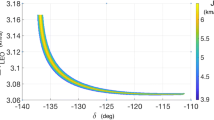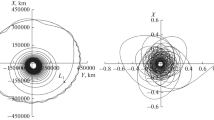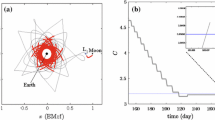Abstract
The problem of designing low-energy transfers between the Earth and the Moon has attracted recently a major interest from the scientific community. In this paper, an indirect optimal control approach is used to determine minimum-fuel low-thrust transfers between a low Earth orbit and a Lunar orbit in the Sun–Earth–Moon Bicircular Restricted Four-Body Problem. First, the optimal control problem is formulated and its necessary optimality conditions are derived from Pontryagin’s Maximum Principle. Then, two different solution methods are proposed to overcome the numerical difficulties arising from the huge sensitivity of the problem’s state and costate equations. The first one consists in the use of continuation techniques. The second one is based on a massive exploration of the set of unknown variables appearing in the optimality conditions. The dimension of the search space is reduced by considering adapted variables leading to a reduction of the computational time. The trajectories found are classified in several families according to their shape, transfer duration and fuel expenditure. Finally, an analysis based on the dynamical structure provided by the invariant manifolds of the two underlying Circular Restricted Three-Body Problems, Earth–Moon and Sun–Earth is presented leading to a physical interpretation of the different families of trajectories.










Similar content being viewed by others
Notes
\(\arctan _2(y,x)\) gives the angle \(\alpha \in (-\,\pi ,\pi ]\) such that \(\cos \alpha = \frac{x}{\sqrt{x^2+y^2}}\) and \(\sin \alpha = \frac{y}{\sqrt{x^2+y^2}}\).
References
Allgower, E.L., Georg, K.: Numerical Continuation Methods: An Introduction. Springer series in computational mathematics. Springer, Berlin (1990)
Bate, R.R., Mueller, D.D., White, J.E.: Fundamentals of Astrodynamics. Dover Publications, New York (1971)
Bertrand, R., Epenoy, R.: New smoothing techniques for solving bang-bang optimal control problems—numerical results and statistical interpretation. Optim. Control Appl. Methods 23(4), 171–197 (2002). https://doi.org/10.1002/oca.709
Betts, J.: Survey of numerical methods for trajectory optimization. J. Guid. Control Dyn. 21(2), 193–207 (1998)
Bryson, A., Ho, Y.C.: Applied Optimal Control: Optimization, Estimation and Control, Halsted Press book. Taylor & Francis, New York (1975)
Chen, Z.: \({{\rm L}}^1\)-optimality conditions for the Circular Restricted Three-Body Problem. Celest. Mech. Dyn. Astron. 126(4), 461–481 (2016). https://doi.org/10.1007/s10569-016-9703-2
Dixon, L.C.W., Biggs, M.C.: The advantages of adjoint-control transformations when determining optimal trajectories by Pontryagin’s maximum principle. Aeronautical J. 76, 169–174 (1972)
Dormand, J., Prince, P.: A family of embedded Runge–Kutta formulae. J. comput. Appl. Math. 6(1), 19–26 (1980)
Edelbaum, T.N.: Propulsion requirements for controllable satellites. ARS(Am Rocket Soc) J Vol: 31. https://doi.org/10.2514/8.5723 (1961)
Filho, L.A.G., da Silva, Fernandes S.: A study of the influence of the Sun on optimal two-impulse Earth-to-Moon trajectories with moderate time of flight in the three-body and four-body models. Acta Astronaut. 134, 197–220 (2017). https://doi.org/10.1016/j.actaastro.2017.02.006
Gómez, G., Jorba, A., Simó, C., Masdemont, J.: Dynamics and Mission Design Near Libration Points, Volume IV: Advanced Methods for Triangular Points. World Scientific, Singapore (2001)
Kato, M., Sasaki, S., Tanaka, K., Iijima, Y., Takizawa, Y.: The Japanese lunar mission SELENE: science goals and present status. Adv. Space Res. 42(2), 294–300 (2008). https://doi.org/10.1016/j.asr.2007.03.049
Kawaguchi, J., Fujiwara, A., Uesugi, T.: Hayabusa its technology and science accomplishment summary and Hayabusa-2. Acta Astronaut. 62(10–11), 639–647 (2008). https://doi.org/10.1016/j.actaastro.2008.01.028
Koon, W., Lo, M., Marsden, J., Ross, S.: Dynamical Systems, the Three-Body Problem and Space Mission Design. Marsden Books, Wellington (2011)
Koon, W.S., Lo, M.W., Marsden, J.E., Ross, S.D.: Low energy transfer to the Moon. Celest. Mech. Dyn. Astron. 81(1), 63–73 (2001). https://doi.org/10.1023/A:1013359120468
McKenzie, R., Szebehely, V.: Non-linear stability around the triangular libration points. Celest. Mech. 23, 223–229 (1981). https://doi.org/10.1007/BF01230727
Mingotti, G., Topputo, F., Bernelli-Zazzera, F.: Efficient invariant-manifold, low-thrust planar trajectories to the Moon. Commun. Nonlinear Sci. Numer. Simul. 17(2), 817–831 (2012). https://doi.org/10.1016/j.cnsns.2011.06.033
Moore, A., Ober-Blbaum, S., Marsden, J.: Trajectory design combining invariant manifolds with discrete mechanics and optimal control. J. Guid. Control Dyn. 35(5), 1507–1525 (2012). https://doi.org/10.2514/1.55426
Oshima, K., Campagnola, S., Yanao, T.: Global search for low-thrust transfers to the Moon in the Planar Circular Restricted Three-Body Problem. Celest. Mech. Dyn. Astron. pp 1–20. https://doi.org/10.1007/s10569-016-9748-2 (2017)
Pérez-Palau, D., Masdemont, J.J., Gómez, G.: Tools to detect structures in dynamical systems using Jet Transport. Celest. Mech. Dyn. Astron. 123(3), 239–262 (2015). https://doi.org/10.1007/s10569-015-9634-3
Powell, M.: A Hybrid Method for Nonlinear Algebraic Equations, pp. 87–114. Gordon and Breach, London (1970)
Qi, Y., Xu, S.: Earth-Moon transfer with near-optimal lunar capture in the Restricted Four-Body Problem. Aerosp. Sci. Technol. 55, 282–291 (2016). https://doi.org/10.1016/j.ast.2016.06.008
Racca, G., Marini, A., Stagnaro, L., van Dooren, J., di Napoli, L., Foing, B., et al.: SMART-1 mission description and development status. Planet. Space Sci. 50(14–15), 1323–1337 (2002). https://doi.org/10.1016/S0032-0633(02)00123-X
Rayman, M.D., Varghese, P., Lehman, D.H., Livesay, L.L.: Results from the deep space 1 technology validation mission. Acta Astronaut. 47(2), 475–487 (2000). https://doi.org/10.1016/S0094-5765(00)00087-4
Ren, Y., Shan, J.: Low-energy lunar transfers using spatial transit orbits. Commun. Nonlinear Sci. Numer. Simul. 19(3), 554–569 (2014). https://doi.org/10.1016/j.cnsns.2013.07.020
Roncoli, R., Fujii, K.: Mission design overview for the Gravity Recovery and Interior Laboratory (GRAIL) mission. In: Proceedings of AIAA/AAS Astrodynamics Specialist Conference (2010)
Russell, C., Barucci, M., Binzel, R., Capria, M., Christensen, U., Coradini, A., et al.: Exploring the asteroid belt with ion propulsion: DAWN mission history, status and plans. Adv. Space Res. 40(2), 193–201 (2007). https://doi.org/10.1016/j.asr.2007.05.083
Russell, R.P.: Primer vector theory applied to global low-thrust trade studies. J. Guid. Control Dyn. 30(3), 460–472 (2007)
Shen, H.X., Casalino, L.: Indirect optimization of three-dimensional multiple-impulse Moon-to-Earth transfers. J. Astronaut. Sci. 61(3), 255–274 (2014). https://doi.org/10.1007/s40295-014-0018-9
Simó, C., Gómez, G., Jorba, À., Masdemont, J., et al.: The Bicircular Model Near the Triangular Libration Points of the RTBP, pp. 343–370. Springer, Boston (1995). https://doi.org/10.1007/978-1-4899-1085-1_34
Simó, C., Sousa-Silva, P., Terra, M.: Practical Stability Domains Near L4,5 in the Restricted Three-Body Problem: Some Preliminary Facts, pp. 367–382. Springer, Berlin (2013). https://doi.org/10.1007/978-3-642-38830-9
Sousa-Silva, P.A., Terra, M.O.: A survey of different classes of Earth-to-Moon trajectories in the patched three-body approach. Acta Astronaut. 123, 340–349 (2016). https://doi.org/10.1016/j.actaastro.2016.04.008. special Section: Selected Papers from the International Workshop on Satellite Constellations and Formation Flying 2015
Szebehely, V.: Theory of Orbits. Academic Press, Cambridge (1967)
Taheri, E., Abdelkhalik, O.: Fast initial trajectory design for low-thrust Restricted Three-Body Problems. J. Guid. Control Dyn. 38(11), 2146–2160 (2015). https://doi.org/10.2514/1.G000878
Tooley, M., Filippone, A., Megson, T., Cook, M., Carpenter, P.W., Houghton, E., et al.: Aerospace Engineering e-Mega Reference. Butterworth-Heinemann, Oxford (2009)
Topputo, F.: On optimal two-impulse Earth-Moon transfers in a four-body model. Celest. Mech. Dyn. Astron. 117(3), 279–313 (2013). https://doi.org/10.1007/s10569-013-9513-8
Zhang, C., Topputo, F., Bernelli-Zazzera, F., Zhao, Y.S.: Low-thrust minimum-fuel optimization in the Circular Restricted Three-Body Problem. J. Guid. Control Dyn. 38, 1501–1510 (2014). https://doi.org/10.2514/1.G001080
Author information
Authors and Affiliations
Corresponding author
Rights and permissions
About this article
Cite this article
Pérez-Palau, D., Epenoy, R. Fuel optimization for low-thrust Earth–Moon transfer via indirect optimal control. Celest Mech Dyn Astr 130, 21 (2018). https://doi.org/10.1007/s10569-017-9808-2
Received:
Revised:
Accepted:
Published:
DOI: https://doi.org/10.1007/s10569-017-9808-2
Keywords
- Low-thrust propulsion
- Minimum-fuel trajectories
- Earth–Moon transfers
- Indirect optimal control
- Bicircular Restricted Four-Body Problem




